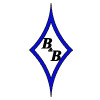Bay River Skiff V.S. Core Sound 17
Posted by Graham Byrnes on Jan 1st 2011
BRS-17 vs CS-17: A Side by Side Comparison
| Bay River Skiff | Core Sound 17 |
The statistics of these two boats are given in tabular form below: The following parameters apply:
Beam is to the outside of the planking and does not include gunwales.
Draft is given at full load condition.
Hull weight is the weight of the hull plus spars, hardware and sails but not stores. This is sometimes called trailer weight, or towing weight.
| LOA 17’ | LOA 17’ |
| Beam 5’ 4½" | Beam 5’ 9½" |
| Draft 6 ½" board up/ | Draft 7½" board up/ 3’ +/- board down |
| SA 114 square feet | Sail Area 119 square feet |
| Weight 360# - 410# | Weight 400# - 450# |
| Sleeping area: aft: 7’ X 5’ 1" /forward section can also be used for extra sleeping area | Sleeping Area: forward: 6’6" (with feet under foredeck for 19 ½" ) X 5’; aft section may be used instead or in addition to the forward section for sleeping. |
| Vessel Uses: Protected water, such as rivers, small bays, small lakes etc…open water in good weather | Vessel Uses: Open Bays, Gulfs, blue Water Coastal |
| Pros: very versatile utility boat, can be use for fishing, crabbing and working when built at standard weight, in addition to sailing. Motoring and rowing are easy, Can be used as a boat to row for pleasure. Slightly easier to build and a little less expensive. | Pros: Dry boat, very protected with side decks. Takes a big load. Foredeck allows use of a dodger for even more protection against spray and weather under way. More boat in the same length, due to higher freeboard and greater volume |
| Cons: Can be wet in a chop, with skiff bow and less freeboard. Takes on water at an earlier angle of heel due to no side decks. | Cons: Can’t be rowed as easily, it is more difficult due to side decks. Less versatile, primarily a sail boat which can use an auxiliary motor or oars for propulsion. Slightly more complex and expensive to build, as there is the additional step of building side decks and optional aft deck |
Note: The bulkheads shown are not in the same fore & aft position on each boat, but do show their forward hull shapes
The best way to better understand the differences between these two boats, is to review their design history. The Bay River Skiff is a much earlier design. The parameters of that assignment were: a good all around utility boat that could be rowed, motored and sailed. A boat that was rugged, yet not too heavy and that could be used for both line fishing and crab potting either commercially or for pleasure. It was also intended to be a work boat for either a small marina or waterfront home owner for help with dock building, line tending, etc…a real "knockabout". The lines above the water are derived from the classic skiffs of the Carolina, particularly the area around Hatteras, NC. The bottom shape is a moderately shallow V form, with a shallow V running aft. This allowed very shallow draft, without the inherent problems of flat bottomed boats, such as pounding, and poor directional stability. It is wider at the chine beam than the traditional skiff, so there is more not less ultimate stability than the traditional boats, and hence better sail carrying.
As the original design was done for a boat-building class project, the method of construction was made simple. There are no frames. The plans offer a choice of construction methods: the standard, for heavy duty, and the lightweight. They also offer two chine construction methods: traditional chine log, or taped seam construction.
In the last 15 years, the design has proven itself to have lived up to and even exceeded it’s design parameters, being an excellent example of the skiff type.
The Core Sound 17 evolved years later. A client wanted to sail a Bay River Skiff 17 along, around and across parts of the Gulf of Mexico. Since real blue water was involved, it was decided to develop a design which would keep the virtues of the Bay River Skiff, but not be limited by the skiff design form. Skiffs as a type have the inherent tendency to produce boats that may be wet due to their low freeboard, straight stem and flat bow sides. Although, the Bay River Skiff is far drier than traditional skiffs, it will take spray and tend to carve through a wave. The points of design which it was decided should be kept was the ease of planing and stability down wind, as well as the cat ketch rig. This rig, beside being charming and traditional for the skiff is a very functional rig for any boat.
The resultant design was a 17 boat with developed convex forward sections with a deeper -V. We had had many years of experience with this design feature in our Spindrift series of dinghies. More bouyant than the skiff type bow, it rides over waves and takes nicely to large blue water conditions. The higher freeboard, and the additional length in the foredeck combined with the full length sidedecks, make this an extremely dry boat with exceptional load carrying capacity. It also allows the crew to be/feel more "inboard" and protected – a great consideration with children and less experienced guests.
One anomaly we’ve noted is that due to the difference in configuration, is that although both boats might sail equally, you "feel" like you’re going faster in the Skiff and "feel" more stable in the Core Sound.





